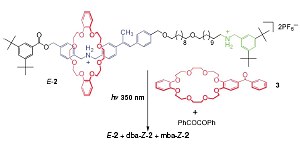In 1867, Scottish physicist James Clerk Maxwell devised a thought experiment that would help scientists find ways of breaking the law. The second law of thermodynamics, that is. The second law of thermodynamics tells us that heat cannot pass from a hotter object to a colder one. But, Maxwell’s demon throws a spanner in the thermodynamics works, violates the law, and allows the impossible to happen.
Physicists have never observed energy moving from cold to hot, they have not seen gas molecules rearrange themselves into a perfect crystal at one end of a room, and they have never demonstrated a perpetual motion machine. All phenomena that would be in violation of the law.

Laying molecular demons to rest (Credit: Leigh et al/Nature)
Chemists at the University of Edinburgh have built a molecular ‘machine’, a tiny ratchet device, that mimics some of the skills of Maxwell’s demon. The molecular demon absorbs light, David Leigh told Spotlight, The neat thing is that it uses the light energy to drive the chemical system away from equilibrium.
Leigh and colleagues, Viviana Serreli, Chin-Fa Lee, and Euan Kay, built their molecular ratchet using a rotaxane – a ring-shaped molecule (dibenzo-24-crown-8-based macrocycle) threaded on an axle-like molecule (a linear thread with two bulky 3,5-di-tert-butylphenyl groups as stoppers on the ends) with two stations on which the ring can lock.

David Leigh
Earlier models of the rotaxane machines built by Leigh and his collaborators at the University of Bologna, Italy, as well as other research teams are activated by interfering with this ring-binding pattern using light, an electrochemical, or chemical signal. These signals all tend to shift the rotaxane system back towards equilibrium.
However, they have now found that information about the location of the ring on the axle, i.e. knowing which station it is at, can be accessed using a light input to alter the way in which the ring moves and how quickly. Light alters the kinetics of the shuttling between stations by flipping the structure of the rotaxane from one form to another. In the second Z-isomeric form, the ring is locked in place at whichever station it sits when the light hits the molecule. In the open E-isomeric form it is free to move between the two stations.
By adding a light-sensitive molecule to the rotaxane solution, the researchers can trap the light energy in this molecule and allow it to be released to the rotaxane for the flip between Z and E forms. However, by carefully choosing this light-sensitive molecule to work more effectively when the ring is in a particular station only they can ensure the rotaxanes all end up in the same state with the ring on the same station when the light hits.
With an ensemble of these molecules the net effect can be to move the rings on all members of the ensemble to the same station at the same time. This is analogous in some ways to gas molecules aligning themselves to form a crystal, although it is not quite so unlikely to occur. The light-sensitive molecule plays the role of Maxwell’s demon and seemingly stacks the thermodynamics cards against the natural flow.
Thankfully, Leigh and his colleagues have a clearer view of what really occurs in the system than any imaginary demon and it turns out that there rotaxane breaks no law of nature it is simply a chemical conjuring trick. That said, the demonstration of a light-driven ratchet effect bodes well for greater control of such molecular machines, which offers yet another reason for hope that chemistry will help us build nanotechnology from the bottom up.
Further reading
Nature, 2007, 445, 523-527;
http://dx.doi.org/10.1038/nature05452
Professor David Leigh
http://www.catenane.net/
The Miniature Rotarians
http://www.reactivereports.com/33/33_2.html
Suggested searches
James Clerk Maxwell
second law thermodynamics